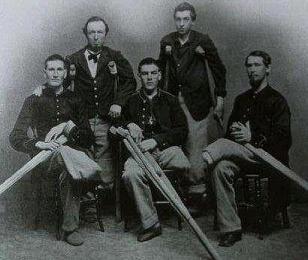 Blindsight: Graham Young Is Blind But Can See
Blindsight: Graham Young Is Blind But Can SeeWhat is consciousness? You may say that it is to be aware. But what does it mean to be consciously aware of something? I can type this paragraph while outside my window a bird chirps, shadows dapple the window ledge, and here, inside, my fingers move on the keyboard, music plays on the radio, and so many other events also happen as I focus only on these words. I stop for a moment, and there they are, all these other things. Then I return my attention to the computer screen. In a sense, I see but I don't see. I am aware but I am not aware. Things are part of conscious and, so to speak, they are not.
Graham Young of Oxford, England is a case in point. When eight years old, he suffered a head injury that damaged the visual cortex of his hind brain, and this experience rendered him unable to see on his right hand side, while he can see on his left. This blindness affects both eyes.
He has a condition called
blindsight, a term coined by Professor Larry Weiskrantz of Oxford University, and it has made Young a prime candidate for neuroscience experiments, particularly because his damage is quite specific and localized, making his situation one of the purest examples of a very rare condition.
If you put an object on his right side and ask, "What is it?" he cannot say.
If you move it, and ask "What direction?" he can tell you. Up, down, left, right. He can do this even though he cannot see the object.
If a neuroscientist moves an object to his left side, he will see it. As the experimenter moves it to his right he will announce the point at which the object disappears from his view. So long as the object remains motionless, Young can only say nothing is there. When a tiny light is moved, he can announce its direction, although he cannot see it.
The experimenter might say that Graham Young must be able to see it, to which he replies, "It's very easy for me to say to you, 'Oh, I saw that move up. . . ' And as soon as I say that, you're going to say, 'Ah, he can see!' No I can't."
Colin Blakemore, an Oxford scientist, thinks that blindsight is extraordinary in its implications for consciousness. The implications are staggering in that to some extent our brains do not depend on consciousness, and if that be the case, then precisely what is it that consciousness adds to our actions? Why do we need it for certain things?
Of his condition, Young says, " I'm aware of individual functions of sight. Sometimes I am aware of a motion, but that motion has no shape, no color, no depth, no form, no contrast. Sometimes I can tell you what orientation it's at, but then we lose everything else."
Blakemore says that Young lacks "the ability to put it all together, and to recognize an object, a thing, something with meaning. . . . so very, very different from what we would normally call vision." Blakemore again: "If there's one thing that this phenomenon of blindsight teaches us, it is that vision is not entirely seeing, that there can be a disconnection from the capacity to respond to visual information and the actual act of being visually aware of something. Those two things can be separated and probably are in our everyday lives. But the problem is that, obviously, we're not aware of the things that we're not aware of. We just don't know the extent to which they play a part."
Of University of California, San Diego, V.S. Ramachandran says, "It's almost as if the patient is using ESP. He can see and yet cannot see. So it's a paradox, it's almost like science fiction. How is this possible? Well, if you look at the anatomy, you can begin to explain this curious syndrome. It turns out from the eyeball to the higher centers of the brain where you interpret the visual image, there's not just one pathway. There are two separate pathways, which subserve different aspects of vision. One of these pathways is the evolutionarily new pathway, the more sophisticated pathway, if you like, that goes from the eyeball through the thalamus to the visual cortex of the brain. Now, you need the visual cortex for consciously seeing something. The other pathway, which is older evolutionarily, and is more prominent in animals like rodents, lower mammals, birds and reptiles, goes to the brain stem, the stalk on which the brain sits. And, from the brain stem, gets relayed eventually to the higher centers of the brain. Specifically, the older pathway going through the brain stem is concerned with reflexive behavior orienting to something important in the visual field, making eye movements, directing your gaze, directing your head toward something important. In these patients, one of these pathways alone is damaged--the visual cortex is damaged. Because that's gone, the patient doesn't see anything consciously. But the other pathway is still intact. And he can use that pathway to guess correctly the direction of movement of an object that he cannot see."
Reptiles depend on unconscious blindsight for their survival. Graham Young: "A lizard, if it wants to catch a fly, for example, it doesn't actually have to see a fly. It doesn't have to recognize a fly. It just has to be aware of something moving. So I suppose me and the lizard are distant cousins."
As I indicated in the opening paragraph, I must screen out certain events in order to write this article. Blindsight seems to enable us to focus on the task at hand. It allows all else to fall into the background. As for this background, Graham Young is completely unaware of anything happening in his right field yet he gets the event correct 90% of the time. While typing I may register events without becoming consciously aware of them.
Somehow we have consciousness, but have little idea how. Graham Young has no consciousness of certain things, and we are just beginning to understand how. Brain scans revealed that when this unconscious process was going on in Graham Young, a primitive vision pathway was being used by the brain to communicate the information. This is unlike normal vision, wherein much more of the brain is used.
Hamlet said that he could be bounded in a nutshell and count himself king of infinite space. Inside the nutshell that is our skull, that may well be what we are.(See
Nova Online, "Secrets of The Mind," 23 Oct. 2001, and BBC, "All Seeing Yet Un-Seeing," 22 Aug. 2000, later shown on BBC2 "Brain Story")




